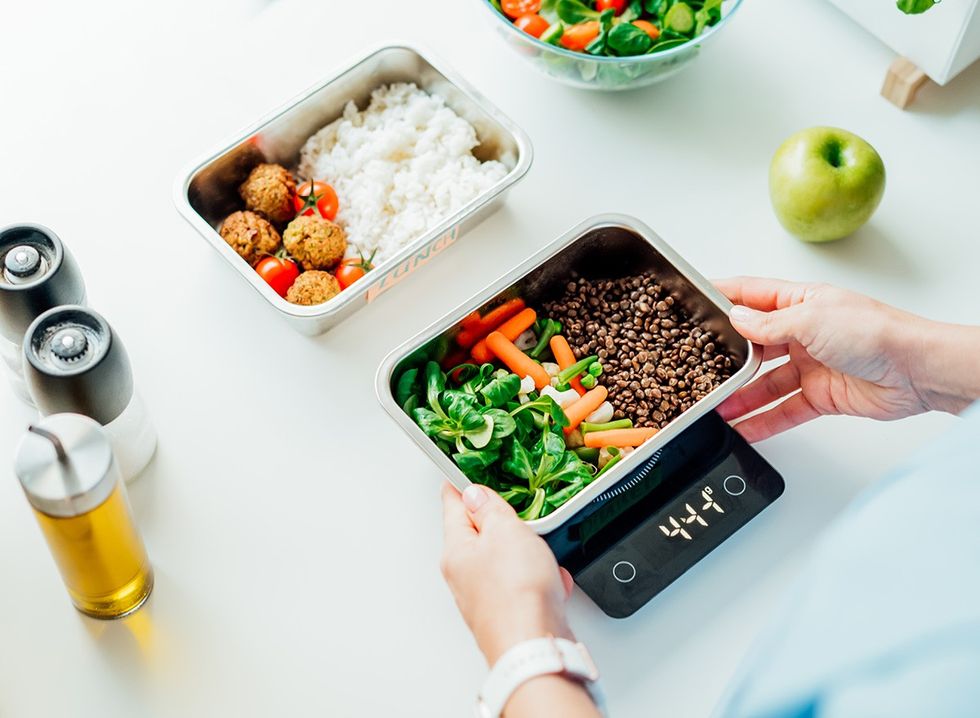Dy Ann Parham, 57, is a Mindset Coach whose priority is “being healthy and fit” and helping others do the same. In a new video, she discusses simple ways to help women over 50 lose weight. "If you are exhausted, frustrated, and confused about what you should be doing as a 50-plus-year-old woman to help you balance out your hormones and allow your body the opportunity to lose some weight, then today's video is for you,” Parham says.
1. Confusing Messages

“Calories in, calories out, debunked. Breakfast is the most important meal of the day, debunked. The entire food pyramid has been demolished and revamped. Carbohydrates were in, and now they're out. Fat was out. Now, it's in how we consume. Protein has changed. High-intensity interval training is now out, and everybody is supposed to be doing zone two training. There is even new scientific research that has debunked the old research about hormone replacement therapy,” she says. “So why is it that we are still seeking out scientific data to make decisions on how it is we should be taking care of ourselves, especially on the most basic level of nutrition and losing weight," Parham adds.
2. She Advocates Intermittent Fasting

“I have been teaching intermittent fasting as a lifestyle approach now for almost eight years,” explains Dy Ann. “I made all the same mistakes you are probably still making with intermittent fasting because of all the buzzwords that are out there. I was limiting the amount of hours I was fasting. I was putting crazy things in my fasting window because that's what all the ‘experts’ were saying to do. I was watching my calories, still like all the other things. Nothing was budging for me, my health journey, and my desire to lose weight until I just made it simple.”
3. She Does a 20-Hour “Clean” Fast

She says that a “20-hour clean fast” helped her reverse her “pre-diabetic condition and to help my body lose weight and help my body lose body fat that I was unhappy with,” she claims. “I really just simplified everything that I could about my intermittent fasting practice as well as what I was doing in my nutrition,” she continues. “It is the simplest way to balance your hunger's hormones out so that you can, in fact, lose weight.”
4. A 20-Hour Fast Helps the Body Regulate Insulin

Dy Ann explains that maintaining “hormonal balance” is key to losing weight. “And that is exactly what the 20-hour fast does for us. It helps us regulate insulin. It helps our body pull from storage. All of this, all of the glycogen that we have been backing up for years and putting away in storage. It helps us regulate our hunger cues, and it just gives us that energy and vitality that we are all looking for. And it is simple, and it is free,” she continues. “There is a little bit of a learning curve and a little bit of a mindset shift that we need to make in order for us to trust our body and give our body the time in the space that it needs to turn inward and feast on itself.”
5. If You Aren’t Losing Weight with Fasting, You Might Be Making Mistakes

“So many women are practicing intermittent fasting and they're still like, ‘Why am I not losing weight?’” she says, explaining that there are some “very common mistakes women are making and most of the time it's just you're making it too complicated,” she says. “If you're going to fast for all of the benefits that fasting can provide for you, then the recommendation I give all women is if you're gonna fast, just fast, if you're asking questions about ‘Does this break a fast?’ or ‘Should I do this during my fasting window?’ then you're probably not approaching an intermittent fasting lifestyle from the right mindset.”
6. Fast Long, Feast Well, Train Smart

“All the things that are going on with you that you are currently researching for a solution for can be found if you just simplify what it is you're doing. We call it fasting long, feasting well, training smart,” she says. “Fast long enough to get the results that you say that you want for yourself and give yourself the benefit of the doubt and just keep that fast clean.”
RELATED: 10 Easy Tips for a Fit Summer Body, Courtesy of Denise Austin
7. When It Comes to Feasing, Find the Foods That Work For You

What does feasting mean? “Figure out the food that works for you. No complicated meal plans to follow. No exhausting grocery shopping halls that you have to do. No endless hours in the kitchen doing food prep. The feasting part is very, very simple. Find the foods that work for you,” she says.
8. Find Your “Rinse and Repeat” Meals

She also recommends finding meals you like and sticking with them. “Be honest about the decision-making process regarding those foods. Meaning are they going to serve what you say you want? Are they gonna allow you the opportunity to look and feel your best? And if they are, those are your go-to foods. We call those our rinse and repeat meals,” Dy Ann says.
9. Incorporate Movement You Enjoy

“Then learn how to move your body in a way that is exciting for you in a way that you look forward to. We do need to start incorporating training smart into our lifestyle, but you get to figure out what it is that works for you,” she explains. “If you're a runner, run, if you're a walker walk, if you play pickleball, play pickleball, whatever it is for you that lights your fire and gets your body moving, then girlfriend, that's what you need to be doing,” she says.
RELATED: 10 Household Tasks to Shed Pounds in Your 50s
9. Keep It Simple

“Forget about all the nonsense that you're hearing on the internet and just make it simple, fast long, feast well, train smart,” she says. “You'll be absolutely amazed at how simple this lifestyle can be. And once you figure out the rhythm of fasting, long feasting well, and training a smart girlfriend, you will have nothing else that you'll need to do. You just keep showing up for you.”
RELATED: 8 Foods I Quit Eating for Weight Loss Over 40
10. Want to Learn More About Intermittent Fasting?

Intermittent fasting works by “prolonging the period when your body has burned through the calories consumed during your last meal and begins burning fat,” explains Johns Hopkins Medicine. If you want to learn more about how to use the method to lose weight, here is a step-by-step process, according to an MD. And if you enjoyed this article, take advantage of these 20 Superfoods for People Over 50.

















 Monitor Your Carbohydrate IntakeShutterstock
Monitor Your Carbohydrate IntakeShutterstock 3. Deep-Fried ItemsShutterstock
3. Deep-Fried ItemsShutterstock Shutterstock
Shutterstock Shutterstock
Shutterstock Don’t Eat High-Sugar FoodsShutterstock
Don’t Eat High-Sugar FoodsShutterstock Shutterstock
Shutterstock Shutterstock
Shutterstock

 I'm a Nutritionist and These 9 High-Protein Snacks Keep My Clients Full While Losing 50 Pounds
I'm a Nutritionist and These 9 High-Protein Snacks Keep My Clients Full While Losing 50 Pounds
 Shutterstock
Shutterstock 2. Processed FoodsShutterstock
2. Processed FoodsShutterstock Shutterstock
Shutterstock Shutterstock/Prostock-studio
Shutterstock/Prostock-studio Shutterstock
Shutterstock Pro TipsShutterstock
Pro TipsShutterstock Shutterstock
Shutterstock Shutterstock
Shutterstock Shutterstock
Shutterstock Shutterstock
Shutterstock Don’t Drink as Much AlcoholShutterstock
Don’t Drink as Much AlcoholShutterstock Most Women on GLP-1s Are Making a Few Common MistakesShutterstock
Most Women on GLP-1s Are Making a Few Common MistakesShutterstock Soda and Sugary DrinksShutterstock
Soda and Sugary DrinksShutterstock Shutterstock
Shutterstock Eat BreakfastShutterstock
Eat BreakfastShutterstock And Improve Insulin SensitivityShutterstock
And Improve Insulin SensitivityShutterstock Belly Flab Strip Tip: Sugar and Fat Calories Leave Its Mark on Your BodyShutterstock
Belly Flab Strip Tip: Sugar and Fat Calories Leave Its Mark on Your BodyShutterstock Shutterstock
Shutterstock The Drugs Mimic the GLP-1 Hormone Naturally Produced by the BodyShutterstock
The Drugs Mimic the GLP-1 Hormone Naturally Produced by the BodyShutterstock